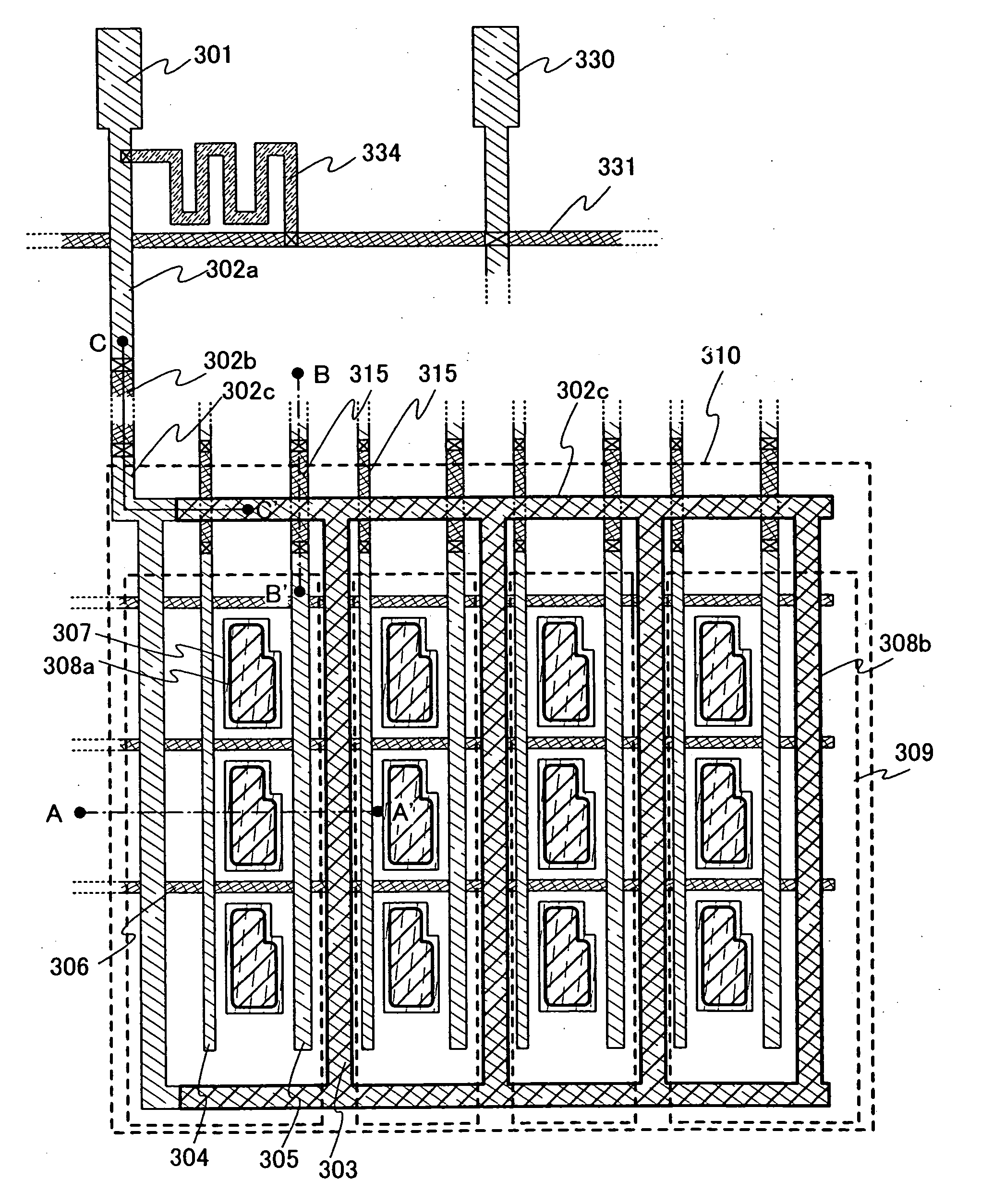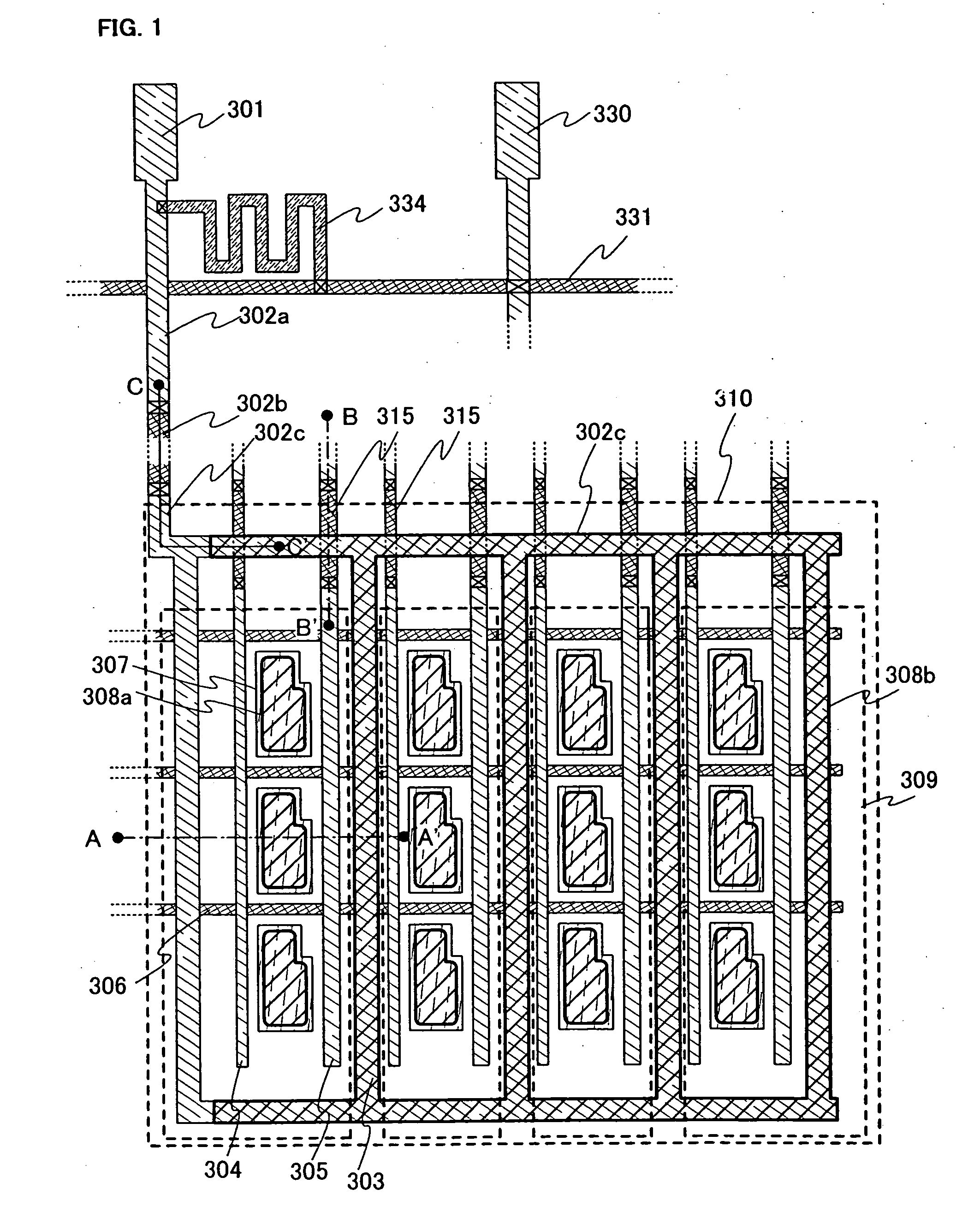Light emitting device and method for fabricating light emitting device
a light emitting device and light emitting device technology, applied in the direction of instruments, discharge tube luminescnet screens, non-linear optics, etc., to achieve the effect of suppressing the potential drop of a counter electrode, high precision and precise pattern
- Summary
- Abstract
- Description
- Claims
- Application Information
AI Technical Summary
Benefits of technology
Problems solved by technology
Method used
Image
Examples
embodiment
[0044] Embodiment Mode 1
[0045] The configuration of a pixel area in a light emitting device of this embodiment mode will be described with reference to FIG. 1. FIG. 1 shows a top view of a pixel area and a leader wiring. Reference numeral 301 denotes a connection terminal, and reference numerals 302a, 302b, and 302c denote leader wirings. Further, an electrode 303 formed in the pixel area is equivalent to an auxiliary electrode, and the electrode is connected to the connection terminal 301 via the leader wirings 302a, 302b, and 302c. In FIG. 1, the connection terminal 301 and the auxiliary electrode 303 are electrically connected by using the three leader wirings of 302a, 302b, and 302c. However, the configuration of leader wirings is not limited to the configuration shown in FIG. 1, and any configuration may be used as long as the connection terminal 301 and the auxiliary electrode 303 can be connected electrically. All of a connection terminal, a leader wiring, and an auxiliary el...
embodiment 1
[0134] Embodiment 1
[0135] In this embodiment, a lay out of a leader wiring, an auxiliary electrode, a signal line, and a power line will be described.
[0136] A top view of a portion where a leader wiring and an auxiliary electrode are connected is shown in FIG. 15. Reference numeral 1201 denotes connection terminals, and the connection terminal is connected to a wiring 1203 via a wiring 1202. Further, the wiring 1203 is connected to a wiring 1205 via a wiring 1204. The wiring 1205 is connected to an auxiliary electrode 1206; more specifically, the wiring 1205 is formed with a conductive film shared by the auxiliary electrode 1206. Accordingly, in the case of FIG. 15, the leader wiring which connect the connection terminals 1201 and the auxiliary electrode 1206 are equivalent to the wirings 1202, 1203, 1204, and 1205.
[0137] Reference numeral 1207 denotes a signal line driver circuit, and the signal line driver circuit supplies a video signal to a signal line 1209 via a wiring 1208. ...
embodiment 2
[0139] Embodiment 2
[0140] In this embodiment, variations on a pixel of the invention will be described.
[0141]FIG. 16A shows an example of a pixel included in the light emitting device of the invention. The pixel shown in FIG. 16A has a light emitting element 901, a transistor used as a switching element for controlling a video signal inputted to the pixel, a driver transistor 903 for controlling a current value supplied to the light emitting element 901, and a current control transistor 904 for selecting whether current is supplied to the light emitting element 901 or not. The pixel may also have a capacitor element 905 for holding a potential of a gate of the transistor 904 as shown in this embodiment mode.
[0142] The switching transistor 902 may be either n-type or p-type. The driver transistor 903 and the current control transistor 904 may be either n-type or p-type, on condition that both of them has the same conductivity type. The driver transistor 903 is operated in a saturat...
PUM
 Login to View More
Login to View More Abstract
Description
Claims
Application Information
 Login to View More
Login to View More - R&D
- Intellectual Property
- Life Sciences
- Materials
- Tech Scout
- Unparalleled Data Quality
- Higher Quality Content
- 60% Fewer Hallucinations
Browse by: Latest US Patents, China's latest patents, Technical Efficacy Thesaurus, Application Domain, Technology Topic, Popular Technical Reports.
© 2025 PatSnap. All rights reserved.Legal|Privacy policy|Modern Slavery Act Transparency Statement|Sitemap|About US| Contact US: help@patsnap.com



